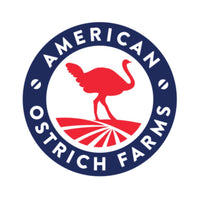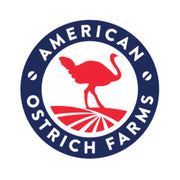In early September, Banger’s, a sausage house and beer garden in Austin, Texas, was hosting its monthly whole-animal roast. But the centerpiece of the dinner didn’t look like anything you might expect. After meeting some people with a connection to an ostrich grower, executive chef Ted Prater had wrangled himself a whole ostrich at a cost of about $1,000. He’d cooked ostrich in the past, but “whole animal cookery is different,” he said—and especially so when it comes to the famously tall bird.
Prater tried to research the best way to cook a whole ostrich online, but there was nothing there. “I talked to [chefs] around the country, and no one had ever cooked a whole ostrich,” he said. The meat should be cooked between medium rare and medium—that much Prater knew. But that was about it. The anatomy of the bird was different from anything he’d seen before. “There’s nothing in the chest area; it’s just a rib cage. Everything is on the rump and legs.” But it was too late to go back, so Prater let it sit in a salt-and-sugar rub for 24 hours, then wrapped the ostrich in bacon—a hedge against the lean meat, which dries out easily—before putting it in the smoker.
Even if the bird turned out perfectly, he knew it might be harder to sell than a pig roast. “I really educated my staff the morning of the smoke-out and prior to it,” Prater said. “I told them not to tell people it tastes like chicken.” When he paraded the raw ostrich through the beer garden on its way to 12 hours in the smoker, people had no idea what he was carrying. “People were interested, and everyone was taking pictures and asking about it,” Prater said.
Despite his guesswork, Prater said he wouldn’t change anything about his preparation. “It was the most beautiful roast you could possibly think of,” he said. “Ostrich is an excellently flavored bird, period.” A lot of people who ended up buying plates had never had ostrich and didn’t realize how delicious it was.
If a dedicated group of ostrich growers throughout the United States have their way, ostrich could be what’s for dinner once more.
•••
Much like with the cartoonish platypus, the blobfish, or the extinct dodo, to know anything about the ostrich is to wonder if it’s some kind of evolutionary joke. It’s a flightless bird that stands up to nine feet tall, can weigh 350 pounds, and can run as fast as 45 miles per hour—roughly the same speed as the horses running the Kentucky Derby. The bird’s long legs and neck are completely bare of feathers, while its body carries a mass of plumes that for centuries people have sought for fashion and feather dusters alike. Although ostriches are now raised in disparate climates around the world, the imprint of their natural range in the arid grasslands and deserts of Africa remains: They don’t need to drink water (they can get all their hydration from plants), and despite their stature, they have a relatively small ecological footprint thanks to their sparse native habitat. The plume market may be a thing of the past, but ostrich meat has potential for the future: Not only can the birds thrive on little, but the low-fat red meat is more akin to beef than any other poultry in the grocery aisle. The only problem is, you can’t often find it there.
Today there are an increasing number of ostrich growers throughout the United States who believe this bird could achieve popularity to match its size. Though some growers see ostrich as more of a tourist attraction than a business, many ranchers have spent decades laying the groundwork for a market that could put an ostrich in every extra large pot. But the bird has a difficult past: Twice, world markets have gambled on ostrich. Both times many got rich—then lost it all.
The first ostrich boom started in the late 1800s in vast, dusty expanses of South Africa’s Little Karoo region. The feathers of the native bird became the fashion item du jour throughout the world, “ounce for ounce, more precious than gold,” as Rob Nixon writes in his book Dreambirds. In the town of Oudtshoorn, you could track the growth of ostrich fortunes by watching all the ornate “feather palaces” being built. American farmers started their own ostrich farms to get a piece of the growing feather rush. In 1913, at the peak of the industry, 100,000 tons of ostrich feathers were shipped from the Little Karoo throughout the world, Nixon writes.
But fashions changed, and before long, ostrich plumes started showing up in feather dusters and cheap toys instead of adorning the finest-quality dresses and hats. Feather-based riches fell as quickly as they’d come.
Then, in the 1980s, the birds came back, and once again thanks to a fashion trend, Ostrich leather was in high demand for bags, shoes, and other items, but antiapartheid sanctions against South Africa slowed the global supply to a halt. Investors became farmers after seeing a way to make a quick buck, perhaps even to pay for retirement. Between 1986 and the 1990s, the cost for a breeding pair of ostrich in the United States increased by 500 percent, to $50,000—though some breeders could command prices of $100,000.
But the boom was self-defeating—no one was going to slaughter birds that were worth so much, for meat or for leather. Even if they’d wanted to, the infrastructure just didn’t exist: There weren’t enough independent slaughterhouses or processing plants that were capable of dealing with the tall birds. In the ’80s and ’90s, ostrich was less of an industry than a pyramid scheme built on the backs of live animals.
In the late 1990s, there were 1,643 ostrich farms in the United States. By 2012, the USDA recorded 258. Some ostriches were simply let out of the gates to roam free, not worth the money to care for. One headline from 1997 read, “County Jail Inmates in Arizona Will Soon Get the Gift of Ostrich Meat.”
Joel Brust paid boom-time prices for the first birds that stalked around Indian Point Ostrich Ranch in Tehachapi, California, but grew his business slowly. He patented a process for cutting the meat that he believes makes the cuts more consistent, tender, and easy to handle. The American public is used to cooking red meat like beef; with ostrich’s vastly lower fat content, it can become dried out and flavorless—not what you want after buying a $40 ostrich steak. This is important when it comes to the fan fillet, the most prized cut on an ostrich. Most consider the fan, taken from the upper thigh, to be the tenderest part as well as the largest cut. It can cost as much as $40 per pound, which is why Brust and other ostrich growers often sell this cut to “white-tablecloth restaurants” or directly to consumers.
Most people who have tried ostrich aren’t eating fan fillets for one simple reason: There are just two per bird, and they cost a lot. That’s why you’re more likely to find ostrich served in burger form, which is both cheaper and more inviting for the non-initiated. Today Tehachapi visitors can find Brust’s ostrich meat, often in ground form, at the local Albertsons grocery or in an ostrich burger from a joint called Burger Spot.
 The meat, and much of the publicity, comes from Brust—but he needs other ostrich growers to work with him under an affiliate program to cultivate the industry. To get ostrich into a Whole Foods, for example, growers would need to guarantee that they could deliver a certain amount of meat. For a lone ostrich grower, that quantity would almost surely be more than he or she could muster. But if a group of farms came together under the umbrella of a single brand, they could likely make it work.
The meat, and much of the publicity, comes from Brust—but he needs other ostrich growers to work with him under an affiliate program to cultivate the industry. To get ostrich into a Whole Foods, for example, growers would need to guarantee that they could deliver a certain amount of meat. For a lone ostrich grower, that quantity would almost surely be more than he or she could muster. But if a group of farms came together under the umbrella of a single brand, they could likely make it work.
While ostrich growers are all hoping the third time will be a charm for the industry, each one wants to believe he or she will become the face of ostrich. Each sees a market waiting to explode that might make it difficult to commit to working “for” somebody’s affiliate and brand. Brust is in his early 70s and, despite his commitment to making ostrich the next red meat, is ready to retire. “I can’t do it all,” he said. He’s been quietly downsizing over the last three years and put his business up for sale early in 2016.
“A lot of people aren’t raising them anymore,” said Boyd Clark, a longtime ostrich grower from Texas and vice president of the American Ostrich Association. “After the crash, so many people got out of the business that there aren’t a lot of people left to get back into it.”
Instead, a whole new generation is stepping up to take a gamble on ostrich.
Alexander McCoy, 34, of American Ostrich Farms in Boise, Idaho, also sees supply—not demand—as the major obstacle to success. “There is a really strong base of consumers who are aware of ostrich, love it, want it, and want more of it,” McCoy said. American Ostrich Farms presold its entire 2016 meat supply through a Kickstarter campaign last fall. Now it’s looking into taking orders for 2017. “If I had the supply, I would have this thing in every regional Whole Foods,” McCoy said. Though consumers are catching on, there aren’t enough growers to go around.
“It’s not about high demand and high supply,” said Lance Appelbaum of New Jersey’s Fossil Farms. “We’re doing it to the way Mother Nature intended it to be.” Just on the East Coast rather than in sub-Saharan Africa.
Fossil Farms started as an ostrich business in 1997 and has expanded into a full-scale purveyor of exotic meats. “If we would have stayed in just ostrich, we would have had a hard time being in business as a one-protein company,” Appelbaum said. Part of its business still involves selling to restaurants, and having more than one product in the truck can give Fossil Farms more income per commute into the city. “Ultimately, we are a farm-to-table company,” Appelbaum said. “I think once chefs realize ostrich is being raised in northern New Jersey their head spins.”
Now they know. If the ostrich growers of America get their way, it won’t be the last time ostrich winds up on a plate.
This article was originally posted by Take Part.







